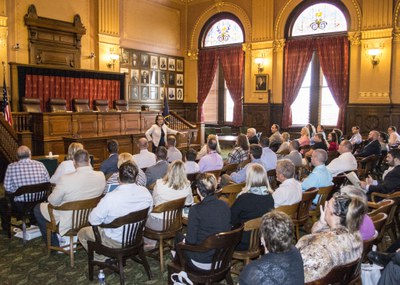
Plan your visit
Indiana Teachers Get a Little Law and Order
September 23, 2016

Look out, Benson and Stabler: Indiana teachers know their law and order. On Aug. 30, IHS and the Indiana Supreme Court co-hosted a workshop giving 60 teachers from all over the state a peek at the inner workings of our state government, and I was there.
It was a full day all morning at the Statehouse, all afternoon here at IHS. (Lots of walking: our Fitbits were appeased.) Teachers learned about the many public resources offered by the Court, then toured the Statehouse. (Hamilton shoutout: just being in the building makes you feel like you’re in the room where it happens.) My favorite part was learning about oral arguments. The Indiana Supreme Court, like the SCOTUS, mostly reviews cases by reading the proceedings of lower courts. But, justices in both courts hear a small percentage of cases as oral arguments instead usually these are cases that the justices think will have significant legal repercussions. Like all Supreme Court cases, the cases heard here have already been tried by lower courts and been appealed all the way up the chain. Each side has only 20 minutes to restate the facts of the case, and to convince the justices that his/her interpretation of the laws at play is most correct and complete. By definition, the cases heard here are complex and important, so that’s not much time to synthesize a lot of information.
After learning about the oral argument process and staging a mock argument, we got to see the real thing. At issue: should a sporting goods store be held responsible for selling a gun that’s later used to shoot a police officer? (More on the case here.) It was fascinating to watch. The advocates (lawyers) sometimes only spoke for a few seconds before the justices politely interrupted to clarify or pose a hypothetical situation. (Apparently, hypothetical examples are ok in the Supreme Court, because the justices are trying to make decisions that will potentially influence future cases.) I was a little dazzled. Everyone talked fast. The tone was fierce yet respectful. I sensed that the justices and advocates care deeply about their work. I sat in the beautiful courtroom, in the chairs that have been there for more than a hundred years, and acknowledged my privilege in having a government that works for me.
After lunch, the teachers toured IHS. My group particularly loved You Are There 1816: Indiana Joins the Nation. The teachers got feisty with Jonathan Jennings and William Hendricks! The group disapproved of the news that William Henry Harrison sold slaves out of Grouseland, and they bristled when the delegates discussed their “civilizing influence” on Native Americans.
For me, the tour brought the day full-circle. It was a gentle reminder of our government’s job: to serve and protect all its citizens even the ones whose voices aren’t always heard.








